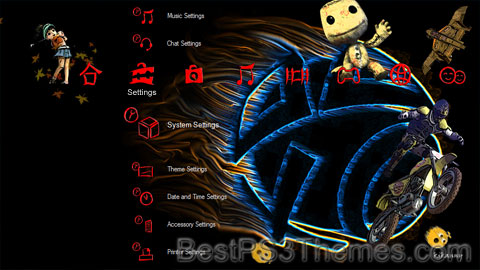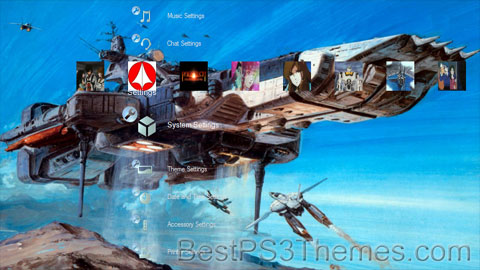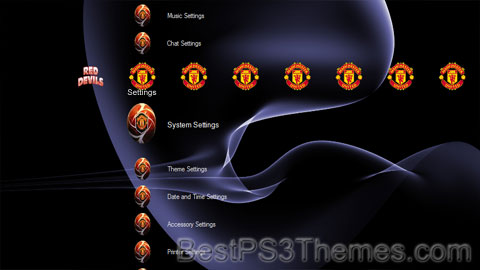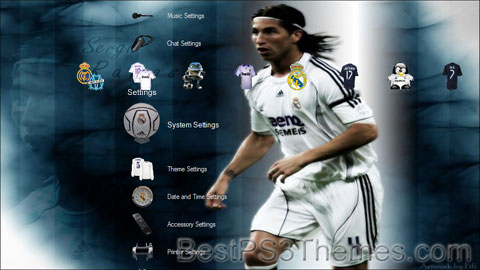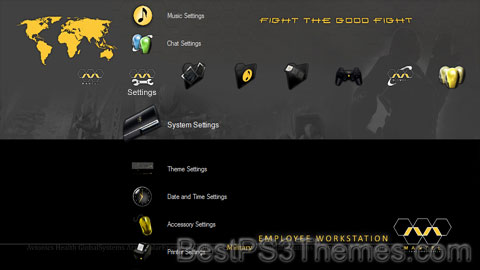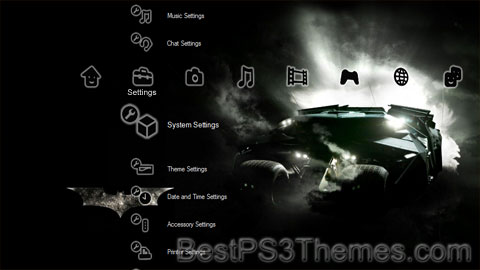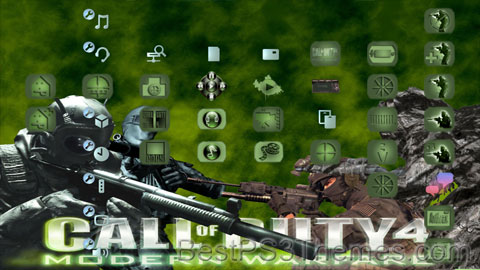Jeep Grand Cherokee theme by Steve
Download: JeepGrandCherokee.p3t
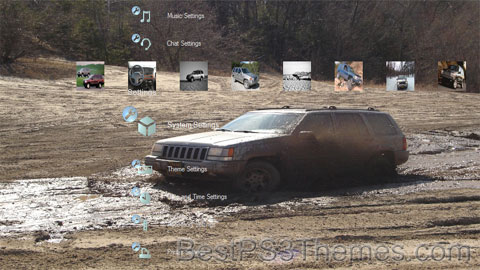
(1 background)
| Jeep Grand Cherokee | |
|---|---|
 | |
| Overview | |
| Manufacturer | Jeep[a] |
| Production | 1992–present |
| Model years | 1993–present |
| Body and chassis | |
| Class |
|
| Body style | 5-door SUV |
| Layout | |
| Chassis | Unibody |
The Jeep Grand Cherokee is a range of mid-size SUVs produced by the American manufacturer Jeep.[1] At its introduction, while most SUVs were still manufactured with body-on-frame construction, the Grand Cherokee has used a unibody chassis from the start.[2]
Development[edit]
The Grand Cherokee's origins date back to 1983 when American Motors Corporation (AMC) was designing a successor to the Jeep Cherokee.[3] Three outside (non-AMC) designers—Larry Shinoda, Alain Clenet, and Giorgetto Giugiaro—were also under contract with AMC to create and build a clay model of the Cherokee XJ replacement, then known as the "XJC" project.[4] However, the basic design for the Cherokee's replacement was well under way by AMC's in-house designers and the 1989 Jeep Concept 1 show car foretold the basic design.[5]
As AMC began the development of the next Jeep in 1985, management created a business process that is now known as product lifecycle management (PLM).[6] According to François Castaing, Vice President for Product Engineering and Development, the smallest U.S. automaker was looking for a way to speed up its product development process to compete better against its larger competitors.[7] The XJC's development was aided by computer-aided design (CAD) software systems making the engineers more productive. Meanwhile, new communication systems allowed potential conflicts to be resolved faster, thus reducing costly engineering changes, because all drawings and documents were in a central database.[7] The system was so effective that after Chrysler purchased AMC in 1987, it expanded the system throughout its enterprise, thus connecting everyone involved in designing and building products.[7]
The Grand Cherokee thus became the first Chrysler-badged Jeep product. Development work for the new Jeep model continued and Chrysler's employees (after the 1987 buyout of AMC) were eager for a late-1980s release date; however, CEO Lee Iacocca was pushing for redesigned Chrysler minivans, thus delaying the Grand Cherokee's release until late 1992[8] as an Explorer competitor. Unlike the Explorer, the Grand Cherokee utilized monocoque (unibody) construction, whereas the Explorer was a derivative of the Ranger pickup with a separate body-on-frame. A Dodge-branded version was designed as a precaution should Jeep dealers struggle to handle so many Grand Cherokee units.[9]
The Grand Cherokee debuted in grand fashion at the 1992 North American International Auto Show in Detroit, Michigan. The vehicle that was driven was a Poppy Red Clear Coat 1993 Grand Cherokee ZJ Laredo with a quartz cloth interior and high-back bucket seats. Then Chrysler president Robert Lutz drove Detroit mayor, Coleman Young, from the Jefferson North Assembly Plant on North Jefferson Avenue via a police escort to Cobo Hall, up the steps of Cobo Hall and through a plate glass window to show off the new vehicle.[10] Sales of the 1993 model year Grand Cherokee began in April 1992.[11]
Production of the Grand Cherokee started shortly afterward in the purpose-built Jefferson North Assembly in Detroit, Michigan. European Grand Cherokees are manufactured in Austria by Magna Steyr.[12] The Grand Cherokee "played a significant part in reviving Chrysler's fortunes by moving it into the then-nascent market for high-margin sports utility vehicles."[13]
Upon its introduction, it was the first full-scale manufacture of an automobile in the US using HFC-134a refrigerant in place of HCFC-12 for the HVAC system.[14]
First generation (ZJ; 1993)[edit]


The original Grand Cherokee was launched in 1992 as a 1993 model year vehicle in the luxury SUV segment. The "ZJ" models, manufactured from 1992 until 1998, originally came in three trim levels: base (also known as SE), Laredo, and Limited, subsequent trims were added, including Orvis (MY 95–98) and TSI (MY97–98). The base model included features such as full instrumentation, a cloth interior, and a standard five-speed manual transmission, while gaining the moniker "SE" name for the 1994 model year. Power windows and locks were not standard equipment on the base trim. The minimal price tag differential resulted in low consumer demand, and as a result, the low-line model was eventually discontinued. Additional standard features included a driver-side airbag and a four-wheel anti-lock braking system (ABS). The Laredo was the mid-scale model with standard features that included power windows, power door locks, cruise control, and a leather-wrapped steering wheel. Exterior features included medium-grey plastic paneling on the lower body and five-spoke alloy wheels. The Limited was the premium model, featuring body-color lower body paneling, and gold exterior accents. The Limited also boasted standard features such as leather seating, heated mirrors, front power seats, a keyless entry system, woodgrain interior appliqué, lace style alloy wheels, a driver information center with a compass, digitized climate control, an electrochromic rearview mirror, and Jensen brand stereo with multi-band equalizer. By 1996 the options list grew to include heated seats. Standard was the 4.0 L engine, with the 5.2 L V8 (and 5.9 L in 1998) being optional, as with other models. Package groups with various trim levels included: fog lamps, and skid plates, as well as convenience, lighting, luxury, power, security, and trailer towing packages.
When it was first introduced in April 1992 as an early 1993 model year vehicle, the Grand Cherokee only had one powertrain choice: the 4.0 L AMC-derived straight-six engine that made 190 horsepower (193 PS; 142 kW). This became the "volume" engine for the Grand Cherokee. Transmission choices included a four-speed automatic transmission (early production ZJs used the AW4—the A500SE (later 42RE) replaced the AW4 during the latter half of the 1993 model year) or an Aisin AX15 manual transmission. Low demand for the manual transmission resulted in its discontinuation after 1994, but European-market ZJs retained it when coupled to the diesel engine (which was unavailable in North America). The drive train choices included rear-wheel drive or four-wheel-drive. In 1995, the engine's rating was reduced by 5 horsepower (5 PS; 4 kW) to 185 horsepower (188 PS; 138 kW) due to new EPA regulations starting with the 1996 model year.
In 1997, for the 1998 model year, a variant of the top-level Grand Cherokee Limited, the "5.9 Limited" was introduced. Jeep ads claimed it to be the "world's fastest sport utility vehicle", verified by third-party testing. The primary improvements in the 5.9 Limited version included a 245-horsepower (248 PS; 183 kW) 5.9 L OHV V8 engine, heavy-duty 46RE automatic transmission, functional heat-extracting hood louvers, unique wide-slot body-colored grille with mesh inserts, special rocker moldings, low-restriction exhaust with three-inch chrome tip, a low-profile roof rack, and special 16" Ultra-Star wheels. The 5.9 Limited also received a 150 amp alternator and a 2-speed electric cooling fan. Other features include a standard 180-watt, 10-speaker Infinity Gold sound system with a rear roof-mounted soundbar, standard sunroof, and an interior swaddled with unique "calf's nap" soft leather and faux wood trim. The 5.9 Limited was awarded "4×4 of the Year" for 1998 by Petersen's 4-Wheel & Off-Road magazine. The production of this model was 14,286 units.
Export models produced at the plant in Graz, Austria, were given the vehicle designation of "ZG".
Engines[edit]
| Years | Engine | Displacement | Power | Torque | Notes |
|---|---|---|---|---|---|
| 1992–1995 | 4.0 L Straight-6 | 242 CID | 190 hp (193 PS; 142 kW) | 225 lb⋅ft (305 N⋅m; 31 kg⋅m) | |
| 1995–1998 | 4.0 L Straight-6 | 242 CID | 185 hp (188 PS; 138 kW) | 220 lb⋅ft (298 N⋅m; 30 kg⋅m) | new emission standards introduced |
| 1992–1994 | 5.2 L V8 | 318 CID | 220 hp (223 PS; 164 kW) | 285 lb⋅ft (386 N⋅m; 39 kg⋅m) | |
| 1994–1998 | 5.2 L V8 | 318 CID | 220 hp (223 PS; 164 kW) | 300 lb⋅ft (407 N⋅m; 41 kg⋅m) | |
| 1995–1998 | 2.5 L TURBO DIESEL | VM Motori/Detroit Diesel | 115 hp (86 kW; 117 PS) | 221 lb⋅ft (300 N⋅m; 31 kg⋅m) | Not Available in North America |
| 1998 | 5.9 L V8 | 360 CID | 245 hp (248 PS; 183 kW) | 345 lb⋅ft (468 N⋅m; 48 kg⋅m) |
Production numbers[edit]
| Model[15] | 1993 | 1994 | 1995 | 1996 | 1997 | 1998 | Total |
|---|---|---|---|---|---|---|---|
| ZJ Grand Cherokee | 250,143 | 257,557 | 290,132 | 299,726 | 277,789 | 271,841 | 1,647,188 |
Second generation (WJ/WG; 1999)[edit]
Launched in September 1998, the redesigned WJ 1999 Grand Cherokee shared just 127 parts with its predecessor (mostly fasteners). The European model was coded WG. The spare tire was relocated from the side of the cargo compartment to under the floor. (Like the 1998MY ZJ, the rear tailgate glass opened separately.) The two heavy pushrod V8 engines were replaced by Chrysler's then-new PowerTech. The new V8 engine produced less torque than the old pushrods, but was lighter, offered better fuel economy, and provided similar on-road performance figures (the 23-US-gallon (87 L; 19 imp gal) fuel tank was replaced with one of a 20.5-US-gallon (78 L; 17.1 imp gal) capacity). The straight-six engine was also updated. A redesign of the intake manifold added 10 horsepower (10 PS; 7 kW). While other Jeep vehicles used the Mopar 5 × 4.5 bolt circle, this was the first Jeep following the 1987 Chrysler buyout to receive a wider bolt pattern—5 × 5.
A notable feature available in this generation was the automatic four-wheel drive option called Quadra-Drive, which employed the New Venture Gear NV247 transfer case. This two-speed chain-driven transfer case uses a gerotor, a clutch pack coupled to a hydraulic pump, to transfer torque between the front and rear axles. The transfer case contains three modes, 4-All Time, Neutral, and 4-Lo. In 4-All Time, 100% of torque is sent to the rear axle in normal conditions. If the rear axle starts spinning at a higher rate than the front axle, hydraulic pressure builds up in the gerotor and causes the clutch pack to progressively transfer torque to the front axle until both axles return to the same speed. A neutral mode is intended for towing the vehicle. In 4-Lo, the front and rear axles are locked together through a 2.72 reduction gear ratio. The NV247 transfer case is mated to front and rear axles containing Jeep's Vari-Lok differentials. Vari-Lok differentials also use a gerotor to transfer torque between the wheels on either side of the axle. The major advantage of Quadra-Drive was that the combined transfer case and progressive locking differentials in each axle could automatically control traction between all four wheels. However, only the center differential could be permanently locked, and only in 4Lo. The Quadra-Trac II system included the NV247 transfer case with the standard open front and rear differentials.
The 45RFE and 545RFE automatic transmission in the WJ was notable. It included three planetary gear sets rather than the two normally used in a four-speed automatic. This gave it six theoretical speeds, and it would have been the first six-speed transmission ever produced in volume, but it was programmed to only use five of these ratios. Four were used for upshifts, with a different second gear for downshifts. Although five of the six ratios were used, Chrysler decided to call it a "4-speed automatic". For MY 2001, the programming was changed to make use of all six ratios. Rather than have six forward gears, the transmission was programmed to act as a five-speed with the alternate second gear for downshifts. The rpm at 70 miles per hour (110 km/h) on a 545RFE is 2,000 rpm, 200 rpm less than the 45RFE programming. 1999 and 2000 model-year WJ owners can have their 45RFE transmission's programming flashed to enable the extra gear as both transmissions are physically the same. (Must purchase new PCM and ABS module and program them with a fake VIN to make this work.) The 42RE 4-speed automatic remained the transmission for the inline 6 engine. It had slight changes from the previous model Grand Cherokee.
The interior was also completely redesigned. The redesign allowed for larger rear doors, and more space for rear passengers. Controls for various items like headlights, heated seats, and rear wiper were moved to more convenient locations. The electronic Vehicle Information center was moved from below the radio to above the windshield and was standard on 2000–2004 models. Limited models included automatic dual-zone climate control. A 10-CD changer was also available with the Infinity Audio package.
In addition to Jeep's UniFrame construction, Daimler Chrysler partnered with Porsche to further strengthen the frame.[citation needed] This was done to reduce Noise Vibration Harshness (NVH). UniFrame is an unusual construction scheme, it incorporates all of the strength and durability of a body-on-frame construction into a unitized construction. By adding stiffness and rigidity to the structure, they enhanced the ride and strengthened the network of steel beams, rails and pillars (or "safety cage") that surround and protect occupants. More than 70 percent of the underbody is high-strength steel. All Jeep Grand Cherokees feature UniFrame construction.
The Grand Cherokee received a minor facelift for 2004 including round fog lamps, a lower front fascia, and a new body color-matched inset grille design.
Export models produced at the plant in Graz, Austria, were given the vehicle designation of "WG".

Engines[edit]
| Model years | Engine | Displacement | Power | Torque | Notes |
|---|---|---|---|---|---|
| 1999–2002 | 3.1 L turbodiesel straight-5 | 3.1 liters (189 CID) | 140 hp (142 PS; 104 kW) | 271 lb⋅ft (367 N⋅m; 37 kg⋅m) | Not available in North America, manufactured by VM Motori |
| 1999–2004 (1999–2005 outside North America) | 4.0 L straight-6 | 4.0 liters (242 CID) | 195 hp (198 PS; 145 kW) | 230 lb⋅ft (312 N⋅m; 32 kg⋅m) | |
| 1999–2004 (1999–2005 outside North America) | 4.7 L V8 | 4.7 liters (287 CID) | 235 hp (238 PS; 175 kW) | 295 lb⋅ft (400 N⋅m; 41 kg⋅m) | |
| 2002–2005 | 2.7 L CRD diesel straight-5 | 2.7 liters (165 CID) | 163 hp (165 PS; 122 kW) | 295 lb⋅ft (400 N⋅m; 41 kg⋅m) | Not available in North America, manufactured by Mercedes-Benz |
| 2002–2004 (2002–2005 outside North America) | 4.7 L "High Output" V8 | 4.7 liters (287 CID) | 265 hp (269 PS; 198 kW) | 325 lb⋅ft (441 N⋅m; 45 kg⋅m) |
Third generation (WK; 2005)[edit]


The WK Grand Cherokee debuted in 2004 for the 2005 model year at the 2004 New York International Auto Show with available Quadra-Drive II four-wheel drive, rear-seat DVD player and optional 5.7 L Hemi V8. The 3.7 L V6 engine replaced the 4.0 L straight-6. A Mercedes-Benz-sourced 3.0 L V6 Common Rail Diesel (CRD) was available outside of North America from launch.
Jeep replaced the XJ-era leading-arms live-axle front suspension (found in the ZJ and WJ) with an independent double-wishbone setup like that which debuted in the 2002 Liberty. Classed as a truck-based SUV, the WH/WK Grand Cherokee offers "crossover" refinement, capability, and NVH.
The 2007 Jeep Grand Cherokee made its European debut at the Euro Camp Jeep in Ardèche, France. This Jeep has gained 4 stars in the Euro NCAP crash safety tests conducted in 2005.
The Grand Cherokee received a minor facelift for 2008 with revised headlights and available High-Intensity Discharge (HID) Headlamps with auto-leveling. The lower portion of the front bumper was still removable as it was from launch to increase the approach angle for off-road use. The 4.7 L was refined, now producing 305 hp (227 kW; 309 PS), and 334 lb⋅ft (453 N⋅m; 46 kg⋅m).
The 2009 Jeep Grand Cherokee is available with an improved 5.7 L Hemi engine rated at 357 hp (362 PS; 266 kW) and 389 lb⋅ft (527 N⋅m; 53.8 kg⋅m) of torque. The engine uses variable valve timing to increase fuel economy.[16]
Engines[edit]
| Years | Engine | Displacement | Power | Torque | Notes |
|---|---|---|---|---|---|
| 2005–2010 | 3.7 L V6 | 225 CID (3,687 cc) | 215 hp (218 PS; 160 kW) | 235 lb⋅ft (319 N⋅m; 32 kg⋅m) | Base, Laredo, Laredo X, Limited |
| 2005–2007 | 4.7 L V8 | 287 CID (4,698 cc) | 230 hp (233 PS; 172 kW) | 295 lb⋅ft (400 N⋅m; 41 kg⋅m) | Laredo, Laredo X, Limited |
| 2008–2009 | 4.7 L V8 | 287 CID (4,698 cc) | 305 hp (309 PS; 227 kW) | 334 lb⋅ft (453 N⋅m; 46 kg⋅m) | Laredo, Laredo X, Limited |
| 2005–2008 | 5.7 L Hemi V8 | 345 CID (5,654 cc) | 325 hp (330 PS; 242 kW) | 369 lb⋅ft (500 N⋅m; 51 kg⋅m) | Laredo X, Limited, Overland |
| 2009–2010 | 5.7 L Hemi V8 | 345 CID (5,654 cc) | 357 hp (362 PS; 266 kW) | 389 lb⋅ft (527 N⋅m; 54 kg⋅m) | Laredo X, Limited, Overland |
| 2006–2010 | 6.1 L Hemi V8 | 370 CID (6,059 cc) | 420 hp (426 PS; 313 kW) | 420 lb⋅ft (569 N⋅m; 58 kg⋅m) | SRT8 |
| 2005–2010 Europe/ 2007–2009 North America | 3.0 L Mercedes-Benz OM642 V6 | 182 CID (2,988 cc) | 215 hp (218 PS; 160 kW) | 376 lb⋅ft (510 N⋅m; 52.0 kg⋅m) | CRD, Predator, Model S, Laredo X, Limited, Overland |
Fourth generation (WK2; 2011)[edit]
The fourth-generation WK2 Grand Cherokee went on sale in summer 2010 as a 2011 model.[17] It was unveiled at the 2009 New York Auto Show.[18] In 2009, during its development, Chrysler management used it as an example of future products to convince United States, federal regulators of Chrysler's future viability, for the purpose of requesting a federal loan. This culminated in the Chrysler Chapter 11 reorganization that same year.
Like previous generations, the WK2 Grand Cherokee chassis is a steel unibody. Unlike previous generations, it features four-wheel independent suspension for better on-road handling. The WK2 and 2011 Durango use a Chrysler-designed and engineered platform/chassis that Mercedes-Benz later used for the Mercedes-Benz W166 series. The Chrysler-designed platform was part of the DaimlerChrysler engineering projects that were to launch the WK2 Grand Cherokee with the Mercedes-Benz ML to follow.
Engine choices include the all-new 3.6 L Pentastar V6 and 5.7 L Hemi V8. The Hemi V8 retains the Multiple Displacement System (MDS) that shuts down four cylinders in low-power driving situations. The V8 included a multi-speed automatic transmission featuring Electronic Range Selection (ERS) to manually limit the high gear operating range. Trailer towing is rated 7,400 pounds (3,357 kg) for Hemi models and 6,800 pounds (3,084 kg) for Pentastar models.[19] A 3.0 L turbocharged diesel V6 developed and built by Fiat Powertrain Technologies and VM Motori (with Multijet II injection[20]) rated at 177 kW (241 PS; 237 hp) and 550 N⋅m (406 lb⋅ft; 56 kg⋅m) of torque offered in export markets from mid-2011.[21] The new 3.0 L CRD turbodiesel engine is available in European markets as 140 kW (190 PS; 188 hp) low-power version.[22]
The new Grand Cherokee SRT8, which started production on July 16, 2011,[23] is equipped with a 470-horsepower (350 kW; 477 PS) 6.4 L Hemi V8 engine. Jeep claims the new SRT8 gets 13 percent better fuel economy than its predecessor.[citation needed]
For the 2022 model year, Jeep marketed the outgoing Grand Cherokee WK2 alongside the all-new Grand Cherokee WL model as the Grand Cherokee WK (not to be confused with the Grand Cherokee (WK), which was produced from 2005 until 2010). The lineup is condensed to base Laredo "E", mid-level Laredo "X", and range-topping Limited trims, with the only engine option being the base 3.6 L Pentastar V6 gasoline engine.[24]
Engines[edit]
| Years | Engine | Displacement | Power | Torque | Notes |
|---|---|---|---|---|---|
| 2011–2022 | 3.6 L Pentastar V6 | 220 CID (3,604 cc) | 295 hp (299 PS; 220 kW) | 260 lb⋅ft (353 N⋅m; 36 kg⋅m) | Laredo, Laredo E, Laredo X, Altitude, Limited, Sterling Edition, Trailhawk, Overland, High Altitude, Summit[25] |
| 2011–2021 | 5.7 L Hemi V8 | 345 CID (5,654 cc) | 360 hp (365 PS; 268 kW) | 390 lb⋅ft (529 N⋅m; 54 kg⋅m) | Laredo X (up to 2013), Altitude (up to 2013), Limited, Sterling Edition, Trailhawk, Overland, High Altitude, Summit[25] |
| 2012–2021 | 6.4 L Hemi V8 | 392 CID (6,417 cc) | 470 hp (477 PS; 350 kW) | 470 lb⋅ft (637 N⋅m; 65 kg⋅m) | SRT8, SRT[26] |
| 2018–2021 | 6.2 L supercharged Hemi V8 | 376 CID (6,166 cc) | 707 hp (717 PS; 527 kW) | 645 lb⋅ft (875 N⋅m; 89 kg⋅m) | Trackhawk[27] |
| 2011–2018 | 3.0 L CRD V6 | 182 CID (2,988 cc) | 140 kW (190 PS; 188 hp) | 440 N⋅m (325 lb⋅ft; 45 kg⋅m) | US-spec lower output to meet emission standards |
| 2014–2020 | 3.0 L CRD V6 | 182 CID (2,988 cc) | 179 kW (243 PS; 240 hp) | 569 N⋅m (420 lb⋅ft; 58 kg⋅m) | Available outside North America from launch. US-spec Limited, Overland, Summit[25] |
Fifth generation (WL; 2021)[edit]
| Fifth generation | |||||||||||||||||||||||||||||||||||||||||||||||||||||||||||||||||
|---|---|---|---|---|---|---|---|---|---|---|---|---|---|---|---|---|---|---|---|---|---|---|---|---|---|---|---|---|---|---|---|---|---|---|---|---|---|---|---|---|---|---|---|---|---|---|---|---|---|---|---|---|---|---|---|---|---|---|---|---|---|---|---|---|---|
 2022 Jeep Grand Cherokee (WL) | |||||||||||||||||||||||||||||||||||||||||||||||||||||||||||||||||
| Overview | |||||||||||||||||||||||||||||||||||||||||||||||||||||||||||||||||
| Model code |
| ||||||||||||||||||||||||||||||||||||||||||||||||||||||||||||||||
| Production | 2021–present | ||||||||||||||||||||||||||||||||||||||||||||||||||||||||||||||||
| Model years | 2021–present (Grand Cherokee L) 2022–present (Grand Cherokee)[29] | ||||||||||||||||||||||||||||||||||||||||||||||||||||||||||||||||
| Assembly |
Playstation PlanetPlaystation Planet theme by kikanny Download: PlaystationPlanet.p3t
P3T Unpacker v0.12 This program unpacks Playstation 3 Theme files (.p3t) so that you can touch-up an existing theme to your likings or use a certain wallpaper from it (as many themes have multiple). But remember, if you use content from another theme and release it, be sure to give credit! Download for Windows: p3textractor.zip Instructions: Download p3textractor.zip from above. Extract the files to a folder with a program such as WinZip or WinRAR. Now there are multiple ways to extract the theme. The first way is to simply open the p3t file with p3textractor.exe. If you don’t know how to do this, right click the p3t file and select Open With. Alternatively, open the p3t file and it will ask you to select a program to open with. Click Browse and find p3textractor.exe from where you previously extracted it to. It will open CMD and extract the theme to extracted.[filename]. After that, all you need to do for any future p3t files is open them and it will extract. The second way is very simple. Just drag the p3t file to p3textractor.exe. It will open CMD and extract the theme to extracted.[filename]. For the third way, first put the p3t file you want to extract into the same folder as p3textractor.exe. Open CMD and browse to the folder with p3extractor.exe. Enter the following: RobotechRobotech theme by Steve Download: Robotech.p3t
Robotech is an American science fiction franchise that began with an 85-episode anime television series produced by Harmony Gold USA in association with Tatsunoko Production; it was first released in the United States in 1984.[1] The show was adapted from three original and distinct, though visually similar, Japanese anime television series (Super Dimension Fortress Macross, Super Dimension Cavalry Southern Cross and Genesis Climber MOSPEADA) to make a series suitable for syndication.[2]  In the series, Robotechnology refers to the scientific advances discovered in an alien starship that crashed on a South Pacific island.[3] With this technology, Earth developed robotic technologies, such as transformable mecha, to fight three successive extraterrestrial invasions.[4] Name origin[edit]Prior to the release of the TV series, the name Robotech was used by model kit manufacturer Revell on their Robotech Defenders line in the mid-1980s. The line consisted of mecha model kits imported from Japan and featured in anime titles such as Super Dimension Fortress Macross (1982), Super Dimension Century Orguss (1983) and Fang of the Sun Dougram (1981). The kits were originally intended to be a marketing tie-in to a similarly named comic book series by DC Comics, which ran for only two issues.[5] At the same time, Harmony Gold licensed the Macross TV series for direct-to-video distribution in 1984, but their merchandising plans were compromised by Revell's prior distribution of the Macross kits. In the end, both parties signed a co-licensing agreement and the Robotech name was adopted for the TV syndication of Macross combined with Super Dimension Cavalry Southern Cross (1984) and Genesis Climber MOSPEADA (1983).[5] Fictional chronology[edit]The Robotech chronology, according to Harmony Gold, is illustrated below:
* Asterisked works are now considered 'secondary continuity'—that is, that their events exist in the continuity of Robotech, but 'don't count' when conflicts arise with the primary continuity that comprises the three-part Robotech TV series and 2006's Robotech: The Shadow Chronicles. In 2002, with the publication of the WildStorm (DC) comics, Harmony Gold officially decided to retcon the Robotech Universe. The following Robotech material is now relegated to the status of secondary continuity:
While these materials are not precisely 'retired' or 'removed' from the continuity, their events are subject to critical review, and are strictly subordinate to the 'official' events of the 85-episode animated series. Television and film[edit]The original television series[edit]Robotech (1984) is an original story adapted with edited content and revised dialogue from the animation of three different mecha anime series:
Harmony Gold's cited reasoning for combining these unrelated series was its decision to market Macross for American weekday syndication television, which required a minimum of 65 episodes at the time (thirteen weeks at five episodes per week).[7] Macross and the two other series each had fewer episodes than required, since they originally aired in Japan as weekly series. On some television stations, the syndicated run was preceded by the broadcast premiere of Codename: Robotech, a feature-length pilot. This combination resulted in a storyline that spans three generations, as mankind must fight three destructive 'Robotech Wars' in succession with various invading forces, each of which is motivated in one way or another by a desire for a powerful energy source called 'protoculture'. While each of the three animated series used for its footage informs its content, the Robotech storyline is distinct and separate from each of them.
Robotech: The Movie[edit]Robotech: The Movie, also called Robotech: The Untold Story, is a feature film and was the first new Robotech adventure created after the premiere of the original series. It uses footage from the Megazone 23 – Part 1 OVA (original video animation; made-for-video animated feature) combined with scenes from "Southern Cross" and additional original animation produced for the film. The original plan for the film was to have it set during the Macross Saga, parallel to the SDF-1's return to Earth from Pluto. The film would also have served as a prequel to the Sentinels, as both projects were initially meant to share many characters. Harmony Gold producer Carl Macek worked with the OVA's original creators to make the story and the new ending work. The film had to be changed again after the distributor of the film, Cannon Films, saw an incomplete rough cut of the film and were upset by it. They ordered Macek to remove multiple scenes from the film and to add more violence (most of the scenes removed were scenes setting up characters and showing female characters interacting). Macek reluctantly did what they ordered, and created a new script and rough edit for the film in less than 24 hours. When the distributors saw Macek act out the new film, they were much more pleased with the new cut.[8] The opening night in Texas received a positive response, but Cannon Films pulled out after noting that most attendants were adults; the bulk of the scheduled advertising for the series was targeted to children. The film had limited success in Argentina and Belgium.[citation needed] In 2011, A&E Home Video released, as a part of their Robotech: The Complete Series collection, a 29-minute version of Robotech: The Movie containing only footage used from "Southern Cross". There was no attempt to remaster the footage.[9] Robotech II: The Sentinels[edit]This aborted American-produced series would have followed the continuing adventures of Rick and Lisa Hunter and the Robotech Expedition during the events of The Masters and The New Generation. The feature-length pilot is composed of the first three (and only) episodes that were produced. The Sentinels featured characters from all three Robotech sagas and introduced the SDF-3 along with an overview of their new mission. The series was planned to have a total of 65 episodes.[10] In Robotech Art 3: The Sentinels, Carl Macek blamed the cancellation of the series on the crash of the Yen/Dollar exchange rate,[11] which caused toy partner Matchbox to withdraw from the project. Harmony Gold lacked the funds to produce the series on its own, and production ceased after only three episodes. Robotech II: The Sentinels was released on VHS by Palladium Books.[12] In 2011, a "remastered" version was released on the A&E DVD set, Robotech: The Complete Original Series DVD. This version has opening titles resembling those found on the "Robotech Remastered" DVDs, as well as a new ending with text explaining the fate of the SDF-3. Also, all of the flashback footage used from "The Macross Saga" has been removed, including the re-used footage from the episode "Wedding Bells".[13] Robotech: The Shadow Chronicles[edit]In 2002, Tommy Yune announced development of a new animated sequel. Originally announced as a television series with a planned 2004 release date, the project was revealed at Anime Expo 2004 as a feature-length film titled Robotech: Shadow Force. The storyline overlaps with and continues from the unresolved ending of the original series. The title of the story arc was soon changed to Robotech: The Shadow Chronicles. The first trailers with finished animation were shown at Anime Expo and Comic-Con International in 2005. It was not until February 2006, when Kevin McKeever, operations coordinator at Harmony Gold, was able to confirm that the pilot movie had been completed. After a series of delays, FUNimation Entertainment was finally announced as the home video, broadcast, and theatrical distributor at the 2006 Comic-Con International in San Diego with the possibility of producing further sequels. Harmony Gold premiered the movie at various film festivals in 2006, and it was first seen by a public audience at MechaCon on August 9, 2006, where it was showcased as a charity screening to help raise funds for the ongoing Hurricane Katrina and Hurricane Rita recovery effort. A limited theatrical run followed in January 2007, and the film was released on DVD on February 6, 2007.[14] A two-disc collector's edition was released in November 2007.[15] Robotech: Love Live Alive[edit]First revealed in late 2011 in the final minutes of Carl Macek's Robotech Universe, a documentary on the making of Robotech dedicated to the then-recent passing of Macek, Love Live Alive is an adaptation of the 1984 Genesis Climber Mospeada OVA, Love Live Alive, incorporating some brand-new animation. The film was released on DVD on July 23, 2013, by Lionsgate Home Entertainment in North America.[16] Other television and film productions[edit]Robotech Wars[edit]This promotional VHS tape created by Matchbox was included with their Robotech Wars playset. This video includes two episodes cobbled together from clips of The Macross Saga. Titled "To the End of the Universe" and "Battle Royale", these episodes contain no new footage, and are not meant to follow any continuity established in the TV series.[17] Robotech III, Robotech IV and Robotech V[edit]
During the production of Robotech II: The Sentinels, Carl Macek had already begun to plot out 13 weeks of a third series title Robotech III: The Odyssey, which would have raised the total number or Robotech episodes 215 had both series been produced. He envisioned two additional series (Robotech IV and Robotech V) to bring the total number of episodes to around 300, one to air every weekday for over a year.[18] For Robotech III: The Odyssey, Macek stated that his plans were to create a time-travel loop, allowing the last episode of The Odyssey to lead directly into the first episode of The Macross Saga.[19] This particular plot detail was eventually adapted into the Robotech novel The End of the Circle by Jack McKinney.[20] In 1986, fan publication Macross Life published an interview with Harmony Gold executive Richard Firth who first mentioned the Robotech IV and Robotech V series plans.[21] Firth said the story would be about a retired Commodore character from The Macross Saga telling a story via flashback, but Macek later refuted that plot detail in a 2007 interview. Macek stated that while he was hoping to do up to five series, nothing was ever written for the final two. Robotech 3000[edit]Macek attempted another sequel with the development of Robotech 3000. This all-CGI series would have been set a millennium in the future of the Robotech universe and feature none of the old series' characters. In the three-minute trailer, an expedition is sent to check on a non-responsive mining outpost and is attacked by "infected" Veritech mecha. The idea was abandoned midway into production after negative reception within the company, negative fan reactions at the FanimeCon anime convention in 2000, and financial difficulties within Netter Digital who was animating the show. During a 2000 San Diego Comic-Con panel, Macek announced the series was would be re-conceptualized as a traditional, hand-drawn animated series, however that idea was abandoned sometime prior to 2002 in favor of development of what would become Robotech: The Shadow Chronicles. The trailer was hosted on the official Robotech website, and was included in the 2007 release of the Robotech: The Shadow Chronicles 2-disc collector's DVD, along with behind-the-scenes motion capture footage. Robotech: Mars Force[edit]In October 2004, veteran animation writer and producer Greg Weisman revealed that he developed an animated spin-off series titled Robotech: Mars Force.[22] When asked about the project, Weisman said that he was under a non-disclosure agreement with Harmony Gold and was only allowed to mention that he developed the series.[23] In 2006, Harmony Gold Creative Director Tommy Yune elaborated on the project in the Space Station Liberty Podcast, saying that Mars Force was a series geared at younger audiences, following the children of the Robotech Expeditionary Force.[24] A similar plot would later be used for the canceled 2014 spin-off, Robotech Academy. Robotech UN Public Service Announcement[edit]A sixty-second public service announcement for the 60th anniversary of the United Nations, featuring Scott Bernard and Ariel, was animated during the production of The Shadow Chronicles. Although it did not use the original voice actors and the dialogue was somewhat out-of-character, it nonetheless marked the first fully completed Robotech footage in many years.[25] Robotech: Shadow Rising[edit]On July 27, 2007, at their Comic-Con International panel, Harmony Gold and Yune unveiled the second entry of the Shadow Chronicles production, titled Robotech: Shadow Rising and was to be a co-production with FUNimation Entertainment. Pre-production reportedly began in February 2007 and a projected release date of sometime in 2009 was originally expected.[26] In 2009 Harmony Gold revealed that production had not moved forward since the summer of 2007, due to the announced development deal of a live-action film deal with Warner Bros. in September 2007.[27] At Comic-Con 2012, Tommy Yune announced that Love Live Alive would pave the way for Shadow Rising,[28] and one year later announced at Anime Expo that they had resumed work on Shadow Rising.[29] Harmony Gold's trademark of the term "Shadow Rising" was filed in 2007, extended in 2010, but abandoned since 2011.[30] Robotech Academy[edit]On July 5, 2014, Harmony Gold started a Kickstarter project for Robotech Academy, which Macek had developed before he died. The goal of this project was to raise US$500,000 to produce a new 24-minute pilot episode. The crowdfunding project was to have closed on August 9, 2014;[31] however, on August 2, the project was canceled with a pledge level of US$194,574, or 39% of its target.[32] Harmony Gold, however, announced that further plans to fund the project were being explored.[33] At the 2014 Long Beach Comic Con, it was announced that the producers at Harmony Gold were in talks with at least one new media network on the prospect of producing the show.[34] As of December 7, 2015, the project remains abandoned. Unofficial and parody productions[edit]In the 1990s, Seishun Shitemasu, an anime fandubbing group, produced the parodies Robotech III: Not Necessarily the Sentinels and Robotech IV: Khyron's Counterattack, using footage from, respectively, Gunbuster and Gundam: Char's Counterattack, continuing the tradition of the original Robotech's adaptation of unrelated anime series into a single continuity. On July 2, 2010, Ecuadorian animator Patricio "Pat" Mosquera uploaded to YouTube a teaser for Robotech Skull Knights. On August 17, 2010, second teaser revealed Rick Hunter standing in front of an image of the VF-4 shown in the final episodes of the original series. Robotech Skull Knights has not been released yet.[35] In July 2013, Patricio Mosquera was included as an animation director in the staff list in the IMDb page of Love Live Alive.[36] On December 31, 2012, Cesar Turturro uploaded to YouTube an Argentine fan trailer for Robotech Valkyrie Project.[37] On December, 2013 the first episode was uploaded to YouTube, and in January 2014, the second episode was also uploaded. The series was cancelled after Harmony Gold issued a "cease and desist" letter to the producers. The team was, however, hired to do the CGI effects for Robotech: Academy. Proposed live-action film[edit]Attempts at producing a live-action Robotech have been in development for an extended time, with numerous writers, directors, and actors attached at various times and the film rights changing between studios. Some time prior to February 2006, the company Kickstart Entertainment (founded by Robotech: The Shadow Chronicles and Robotech 3000 producer Jason Netter) featured a graphic on their website stating that a live-action Robotech movie was in development with Chuck Russel attached to write and direct. While never formally announced by Harmony Gold, Kickstart Entertainment's announcement of this project was reported by Anime News Network on February 27, 2006.[38] Anime News Network's article was updated on March 1, 2006 saying that this announcement had been removed. On September 7, 2007, The Hollywood Reporter announced that Warner Bros. had acquired the film rights to Robotech, with Tobey Maguire producing and pursuing the lead role.[39] A Harmony Gold representative stated that the company had been approached by WB and would have "a say" in the film's creative direction.[40] A March 2021 review of a 2008 draft written by S. Craig Zahler by the website Scriptshadow revealed the initial plot was very loosely based on The Macross Saga portion of Robotech.[41] Writers attached to the project included Lawrence Kasdan in June 2008,[42] Alfred Gough and Miles Millar in November 2008,[43] Tom Rob Smith in June 2009,[44] and Michael B. Gordon in February 2015.[45] Nic Mathieu had been announced as director in early 2013.[46] On March 25, 2015, the Robotech franchise was acquired by Sony Pictures;[47] on July 3, 2015, Harmony Gold clarified that Sony has the rights to release the film worldwide with the exception of Japan.[48] After Harmony Gold and Big West reached an agreement which was signed on March 1, 2021 regarding to the Macross and Robotech franchises, announced on April 8, 2021, Big West officially affirmed as part of the deal that they will not take any opposition on Harmony Gold's upcoming live action adaptation of Robotech. Both Harmony Gold and Big West will cooperate on future projects for the foreseeable future.[49][50] For the Sony production, James Wan was announced in 2015 to direct a script written with Kurt Johnstad;[51] Andy Muschietti took over the project in 2017 after Wan dropped out to direct Aquaman,[52] with Jason Fuchs writing the screenplay from scratch.[53] On April 27, 2022, it was reported that Hawkeye producer and director Rhys Thomas will be directing the film, with duo Art Marcum and Matt Holloway writing.[54] In June 2023, artist Col Price posted images on both social media and his official ArtStation page of concept art he was hired to create for the film.[55] [56] While only citing "a few years ago" as the time frame of which they were made, Price's images depict an adaptation of The Macross Saga. Other media[edit]At the time of its broadcast, Harmony Gold also launched Robotech through a popular line of comics to be followed by novels, role-playing games, toys, and other consumer products. With the cancellation of Robotech II: The Sentinels, many of these licensed products were discontinued, and led to a drought of Robotech product through much of the 1990s, except for publishers who continued The Sentinels storyline in print. Art books[edit]In 1986, Starblaze Graphics published Robotech Art 1, a reference book containing artwork, Japanese production designs, and episode guides from the original television series. This was followed by Robotech Art 2, which was largely a collection of art by various American artists and fans. In 1988, Carl Macek collected much of the unused designs from Robotech II: The Sentinels into Robotech Art 3: The Sentinels, which also included his story outline for the rest of the unfinished series, with an explanation behind its cancellation. In 2007, Stone Bridge Press published The Art of Robotech: The Shadow Chronicles. Comics[edit]Robotech comics were first published in 1984 with DC Comics' short-lived Robotech Defenders and Comico's adaptation of the first episode of the Japanese version of Macross. However, the first adaptation of the Robotech television series did not arrive until 1984 with Comico's Robotech: The Macross Saga Number 2, which continued from the first Macross issue. The various comic publishers include:
Collectible card game[edit]The first Robotech collectible card game was release ManchesterManchester theme by zlatan-62100 Download: Manchester.p3t
Manchester (/ˈmæntʃɪstər, -tʃɛs-/ )[6][7] is a city and metropolitan borough of Greater Manchester, England, which had a population of 552,000 at the 2021 census.[5] It contributes to one of the largest metropolitan populations in the United Kingdom as a part of Greater Manchester, which has a population of approximately 2.92 million.[8] It is bordered by the Cheshire Plain to the south, the Pennines to the north and east, and the neighbouring city of Salford to the west. The city borders the boroughs of Trafford, Stockport, Tameside, Oldham, Rochdale, Bury and Salford. The history of Manchester began with the civilian settlement associated with the Roman fort (castra) of Mamucium or Mancunium, established in about AD 79 on a sandstone bluff near the confluence of the rivers Medlock and Irwell. Throughout the Middle Ages, Manchester remained a manorial township but began to expand "at an astonishing rate" around the turn of the 19th century. Manchester's unplanned urbanisation was brought on by a boom in textile manufacture during the Industrial Revolution[9] and resulted in it becoming the world's first industrialised city.[10] Historically part of Lancashire, areas of Cheshire south of the River Mersey were incorporated into Manchester in the 20th century, including Wythenshawe in 1931. Manchester achieved city status in 1853. The Manchester Ship Canal opened in 1894, creating the Port of Manchester and linking the city to the Irish Sea, 36 miles (58 km) to the west. The city's fortune declined after the Second World War, owing to deindustrialisation, and the IRA bombing in 1996 led to extensive investment and regeneration.[11] Following considerable redevelopment, Manchester was the host city for the 2002 Commonwealth Games. The city is notable for its architecture, culture, musical exports, media links, scientific and engineering output, social impact, sports clubs and transport connections. Manchester Liverpool Road railway station is the world's oldest surviving inter-city passenger railway station.[12] At the University of Manchester, Ernest Rutherford first split the atom in 1917; Frederic C. Williams, Tom Kilburn and Geoff Tootill developed the world's first stored-program computer in 1948; and Andre Geim and Konstantin Novoselov first isolated graphene in 2004. Manchester has a large urban sprawl, which forms from the city centre into the other neighbouring authorities; these include The Four Heatons, Failsworth, Prestwich, Stretford, Sale, Droylsden, Old Trafford and Reddish. The city is also contiguous with Salford and its borough but is separated from it by the River Irwell. This urban area is cut off by the M60, also known as the Manchester Outer Ring Road, which runs in a circular around the city and these areas. It joins the M62 to the north-east and the M602 to the west, as well as the East Lancashire Road and A6. Toponymy[edit]The name Manchester originates from the Latin name Mamucium or its variant Mancunio and the citizens are still referred to as Mancunians (/mænˈkjuːniən/). These names are generally thought to represent a Latinisation of an original Brittonic name. The generally accepted etymology of this name is that it comes from Brittonic *mamm- ("breast", in reference to a "breast-like hill").[13][14] However, more recent work suggests that it could come from *mamma ("mother", in reference to a local river goddess). Both usages are preserved in Insular Celtic languages, such as mam meaning "breast" in Irish and "mother" in Welsh.[15] The suffix -chester is from Old English ceaster ("Roman fortification", itself a loanword from Latin castra, "fort; fortified town").[14][13] The city is widely known as "the capital of the North".[16][17][18][19] History[edit]Early history[edit]The Brigantes were the major Celtic tribe in what is now known as Northern England; they had a stronghold in the locality at a sandstone outcrop on which Manchester Cathedral now stands, opposite the bank of the River Irwell.[20] Their territory extended across the fertile lowland of what is now Salford and Stretford. Following the Roman conquest of Britain in the 1st century, General Agricola ordered the construction of a fort named Mamucium in the year 79 to ensure that Roman interests in Deva Victrix (Chester) and Eboracum (York) were protected from the Brigantes.[20] Central Manchester has been permanently settled since this time.[21] A stabilised fragment of foundations of the final version of the Roman fort is visible in Castlefield. The Roman habitation of Manchester probably ended around the 3rd century; its civilian settlement appears to have been abandoned by the mid-3rd century, although the fort may have supported a small garrison until the late 3rd or early 4th century.[22] After the Roman withdrawal and Saxon conquest, the focus of settlement shifted to the confluence of the Irwell and Irk sometime before the arrival of the Normans after 1066.[23] Much of the wider area was laid waste in the subsequent Harrying of the North.[24][25]  Real MadridReal Madrid theme by bizarro Download: RealMadrid.p3t
Redirect to:
HAZE – Mantel Global IndustriesHAZE – Mantel Global Industries theme by SaintDaveUK Download: HazeMGI.p3t
P3T Unpacker v0.12 This program unpacks Playstation 3 Theme files (.p3t) so that you can touch-up an existing theme to your likings or use a certain wallpaper from it (as many themes have multiple). But remember, if you use content from another theme and release it, be sure to give credit! Download for Windows: p3textractor.zip Instructions: Download p3textractor.zip from above. Extract the files to a folder with a program such as WinZip or WinRAR. Now there are multiple ways to extract the theme. The first way is to simply open the p3t file with p3textractor.exe. If you don’t know how to do this, right click the p3t file and select Open With. Alternatively, open the p3t file and it will ask you to select a program to open with. Click Browse and find p3textractor.exe from where you previously extracted it to. It will open CMD and extract the theme to extracted.[filename]. After that, all you need to do for any future p3t files is open them and it will extract. The second way is very simple. Just drag the p3t file to p3textractor.exe. It will open CMD and extract the theme to extracted.[filename]. For the third way, first put the p3t file you want to extract into the same folder as p3textractor.exe. Open CMD and browse to the folder with p3extractor.exe. Enter the following: Batman versionDBatman versionD theme by Deemy Download: Batman_versionD.p3t
P3T Unpacker v0.12 This program unpacks Playstation 3 Theme files (.p3t) so that you can touch-up an existing theme to your likings or use a certain wallpaper from it (as many themes have multiple). But remember, if you use content from another theme and release it, be sure to give credit! Download for Windows: p3textractor.zip Instructions: Download p3textractor.zip from above. Extract the files to a folder with a program such as WinZip or WinRAR. Now there are multiple ways to extract the theme. The first way is to simply open the p3t file with p3textractor.exe. If you don’t know how to do this, right click the p3t file and select Open With. Alternatively, open the p3t file and it will ask you to select a program to open with. Click Browse and find p3textractor.exe from where you previously extracted it to. It will open CMD and extract the theme to extracted.[filename]. After that, all you need to do for any future p3t files is open them and it will extract. The second way is very simple. Just drag the p3t file to p3textractor.exe. It will open CMD and extract the theme to extracted.[filename]. For the third way, first put the p3t file you want to extract into the same folder as p3textractor.exe. Open CMD and browse to the folder with p3extractor.exe. Enter the following: HAZE #7Call of Duty 4 #10Call of Duty 4 theme by Seoulspirit (aka TylerFortier) Download: CallofDuty4_10.p3t
Redirect to: Paint SplatterPaint Splatter theme by Jewad Alnabi Download: PaintSplatter.p3t
P3T Unpacker v0.12 This program unpacks Playstation 3 Theme files (.p3t) so that you can touch-up an existing theme to your likings or use a certain wallpaper from it (as many themes have multiple). But remember, if you use content from another theme and release it, be sure to give credit! Download for Windows: p3textractor.zip Instructions: Download p3textractor.zip from above. Extract the files to a folder with a program such as WinZip or WinRAR. Now there are multiple ways to extract the theme. The first way is to simply open the p3t file with p3textractor.exe. If you don’t know how to do this, right click the p3t file and select Open With. Alternatively, open the p3t file and it will ask you to select a program to open with. Click Browse and find p3textractor.exe from where you previously extracted it to. It will open CMD and extract the theme to extracted.[filename]. After that, all you need to do for any future p3t files is open them and it will extract. The second way is very simple. Just drag the p3t file to p3textractor.exe. It will open CMD and extract the theme to extracted.[filename]. For the third way, first put the p3t file you want to extract into the same folder as p3textractor.exe. Open CMD and browse to the folder with p3extractor.exe. Enter the following: | ||||||||||||||||||||||||||||||||||||||||||||||||||||||||||||||||





